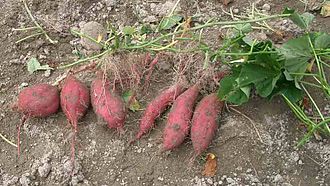Tuber
(Redirected from Tuberous root)
Tuber
A tuber is a type of plant structure that is enlarged to store nutrients. It is a modified stem or root that serves as a storage organ for the plant, allowing it to survive adverse conditions such as winter or drought. Tubers are an important source of food for humans and animals and are cultivated worldwide for their nutritional value.
Types of Tubers
Tubers can be classified into two main types: stem tubers and root tubers.
Stem Tubers
Stem tubers are formed from thickened rhizomes or stolons. The most well-known example of a stem tuber is the potato (Solanum tuberosum), which is a staple food in many parts of the world.
Other examples of stem tubers include the yam (Dioscorea species) and the taro (Colocasia esculenta). These tubers are rich in carbohydrates and are used in a variety of culinary dishes.
Root Tubers
Root tubers are formed from thickened roots. The sweet potato (Ipomoea batatas) is a well-known example of a root tuber. Unlike the potato, which is a stem tuber, the sweet potato is derived from the root of the plant.
Other examples of root tubers include the cassava (Manihot esculenta) and the dahlia (Dahlia species). These tubers are also important food sources and are cultivated in many tropical and subtropical regions.
Cultivation and Uses
Tubers are cultivated for their nutritional value and versatility in cooking. They are rich in carbohydrates, vitamins, and minerals, making them an essential part of the diet in many cultures.
Nutritional Value
Tubers are a significant source of energy due to their high carbohydrate content. They also provide essential nutrients such as vitamin C, potassium, and dietary fiber. The nutritional composition of tubers can vary depending on the species and growing conditions.
Culinary Uses
Tubers are used in a wide range of culinary applications. They can be boiled, baked, fried, or mashed, and are often used as a base for soups, stews, and casseroles. In some cultures, tubers are fermented or dried for preservation.
Examples of Tubers
Several plants produce tubers that are important for food and agriculture:
- Solanum tuberosum (Potato)
- Ipomoea batatas (Sweet Potato)
- Dioscorea species (Yam)
- Colocasia esculenta (Taro)
- Manihot esculenta (Cassava)
- Ullucus tuberosus (Ulluco)
Ecological and Economic Importance
Tubers play a crucial role in ecosystems as a food source for various animals. They are also economically important as they are a major agricultural product in many countries.
Related Pages
Transform your life with W8MD's budget GLP-1 injections from $125.
W8MD offers a medical weight loss program to lose weight in Philadelphia. Our physician-supervised medical weight loss provides:
- Most insurances accepted or discounted self-pay rates. We will obtain insurance prior authorizations if needed.
- Generic GLP1 weight loss injections from $125 for the starting dose.
- Also offer prescription weight loss medications including Phentermine, Qsymia, Diethylpropion, Contrave etc.
NYC weight loss doctor appointments
Start your NYC weight loss journey today at our NYC medical weight loss and Philadelphia medical weight loss clinics.
- Call 718-946-5500 to lose weight in NYC or for medical weight loss in Philadelphia 215-676-2334.
- Tags:NYC medical weight loss, Philadelphia lose weight Zepbound NYC, Budget GLP1 weight loss injections, Wegovy Philadelphia, Wegovy NYC, Philadelphia medical weight loss, Brookly weight loss and Wegovy NYC
|
WikiMD's Wellness Encyclopedia |
| Let Food Be Thy Medicine Medicine Thy Food - Hippocrates |
Medical Disclaimer: WikiMD is not a substitute for professional medical advice. The information on WikiMD is provided as an information resource only, may be incorrect, outdated or misleading, and is not to be used or relied on for any diagnostic or treatment purposes. Please consult your health care provider before making any healthcare decisions or for guidance about a specific medical condition. WikiMD expressly disclaims responsibility, and shall have no liability, for any damages, loss, injury, or liability whatsoever suffered as a result of your reliance on the information contained in this site. By visiting this site you agree to the foregoing terms and conditions, which may from time to time be changed or supplemented by WikiMD. If you do not agree to the foregoing terms and conditions, you should not enter or use this site. See full disclaimer.
Credits:Most images are courtesy of Wikimedia commons, and templates, categories Wikipedia, licensed under CC BY SA or similar.
Translate this page: - East Asian
中文,
日本,
한국어,
South Asian
हिन्दी,
தமிழ்,
తెలుగు,
Urdu,
ಕನ್ನಡ,
Southeast Asian
Indonesian,
Vietnamese,
Thai,
မြန်မာဘာသာ,
বাংলা
European
español,
Deutsch,
français,
Greek,
português do Brasil,
polski,
română,
русский,
Nederlands,
norsk,
svenska,
suomi,
Italian
Middle Eastern & African
عربى,
Turkish,
Persian,
Hebrew,
Afrikaans,
isiZulu,
Kiswahili,
Other
Bulgarian,
Hungarian,
Czech,
Swedish,
മലയാളം,
मराठी,
ਪੰਜਾਬੀ,
ગુજરાતી,
Portuguese,
Ukrainian
Contributors: Prab R. Tumpati, MD





